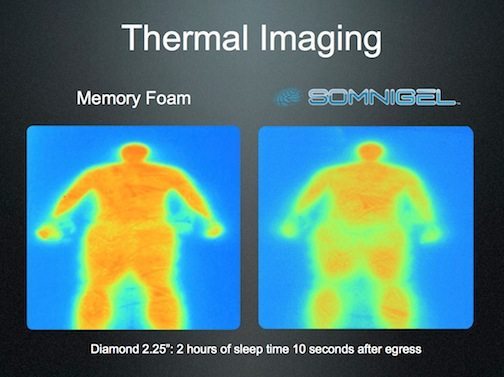
New research Leggett & Platt used infrared imaging to compare the temperature-regulation properties of SomniGel buckling gel with memory foam.
A three-phase research study commissioned by industry supplier Leggett & Platt, coinciding with the launch earlier this year of SomniGel buckling gel, shows that the new mattress component—designed for the bed’s comfort layers—offers temperature-regulating properties.
SomniGel has “measurable thermal properties that provide a ‘true cool story’ when compared with memory foam,” said Cody Messner, product manager of the Carthage, Missouri-based company’s Bedding Components group.
The company validated its in-house lab results with third-party research from the Institute of Environmental Research at Kansas State University in Manhattan, Kansas. The institute is part of the university’s engineering department and specializes in the study of the thermal interaction of people and their surroundings.
All three phases of the study involved the comparison of identical mattresses with a differing top comfort layer. Beds were built with either SomniGel Diamond or with memory foam of the same thicknesses.
In the first phase of research, infrared images of the beds’ surfaces were taken after test subjects occupied them for two-hour periods.
The SomniGel beds showed cooler thermal imaging as compared with the memory foam-only models, Messner said.
In the research’s second phase, L&P compressed the beds’ surfaces with a heated aluminum plate. A thermocouple was placed between the plate and the surface of the mattress to measure surface temperature. After more than 4.5 hours the SomniGel mattress surface temperature was cooler by an average of more than 5 degrees, as compared with the memory foam.
The testing was repeated with various configurations of SomniGel and showed similar results, the company said.
In the final phase of the research, Kansas State designed a test to measure “heat flux” at the surface of the SomniGel and memory foam mattresses used in the study. Heat flux is defined as the rate of heat energy transfer through a given surface.
Thermo-regulated manikins were heated to 95 degrees and placed on the beds. The amount of energy consumed by the manikins back and shoulder area was measured and recorded for four hours on each of three mattress constructions. Results showed considerably more energy consumption on the SomniGel mattresses than the memory foam.
This finding validated that SomniGel provides greater heat flux (up to 113% greater during the first hour) through the surface of the mattress than memory foam. The inverse of heat flux is “thermal resistance” or insulation. Memory foam had greater thermal resistance, indicating better insulating properties, i.e., warmer sleep.




